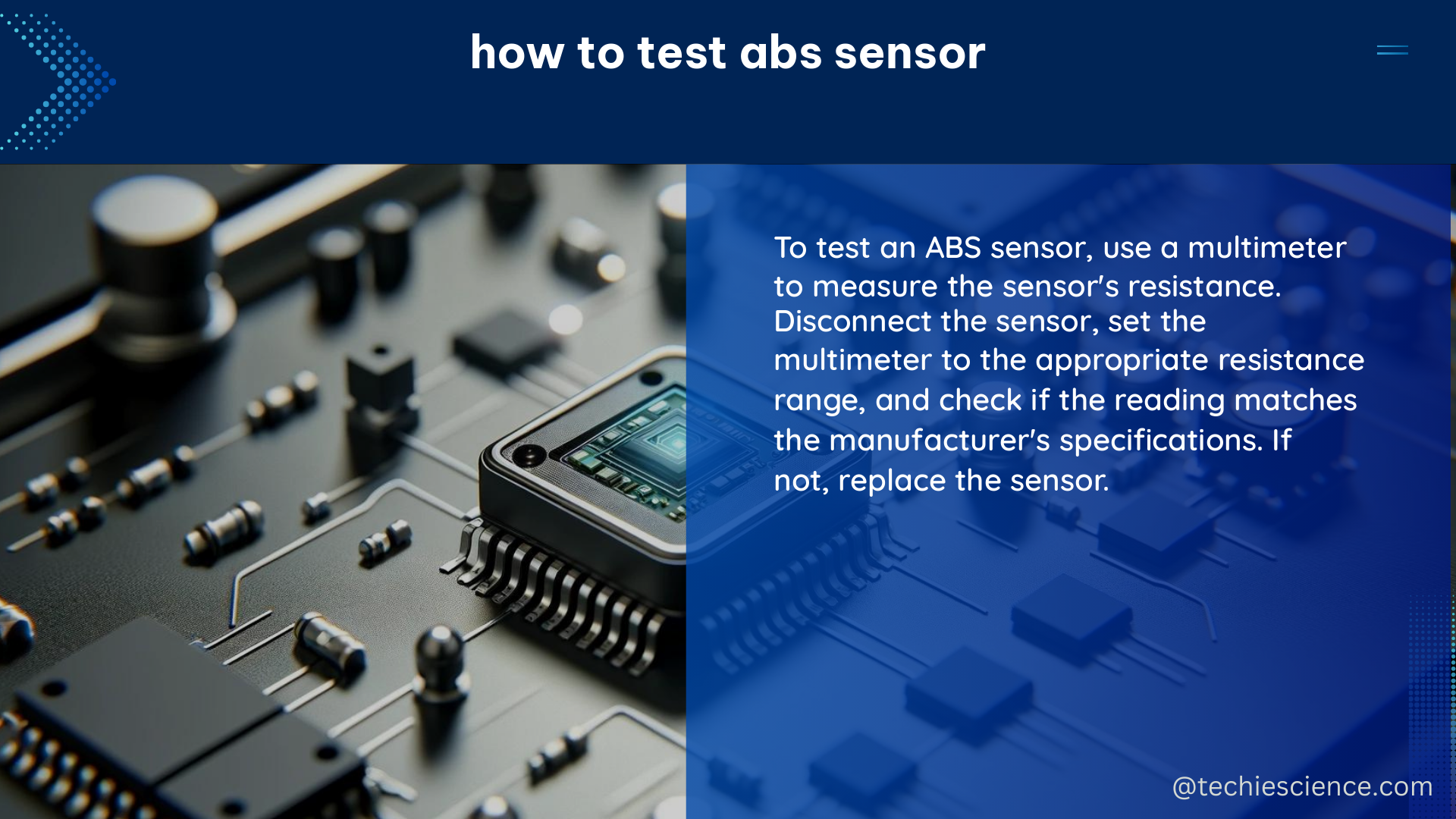The Anti-Lock Braking System (ABS) is a crucial safety feature in modern vehicles, designed to prevent the wheels from locking up during sudden braking, improving the vehicle’s stability and control. The ABS sensor, also known as a wheel speed sensor, plays a vital role in this system by continuously monitoring the rotational speed of each wheel. Properly testing and maintaining the ABS sensor is essential to ensure the system’s proper functioning and the overall safety of the vehicle. In this comprehensive guide, we will delve into the step-by-step process of how to test an ABS sensor, providing you with the necessary knowledge and tools to diagnose and address any issues.
Preparation: Gathering the Necessary Tools and Equipment
Before you begin the testing process, it’s essential to ensure that you have the right tools and equipment at your disposal. This includes:
- Diagnostic Unit: A diagnostic tool, such as a digital multimeter or a specialized ABS diagnostic scanner, is necessary to read and interpret the sensor’s signals and performance data.
- Vehicle-Specific Repair Manual: Refer to the manufacturer’s repair manual for your specific vehicle model to obtain the necessary specifications and guidelines for testing the ABS sensor.
- Adapter (if needed): Depending on the vehicle, you may need to use an adapter to connect the diagnostic unit to the ABS sensor’s wiring harness.
- Safety Equipment: Adhere to the vehicle manufacturer’s safety instructions and wear appropriate personal protective equipment (PPE) during the testing process.
Diagnosis: Connecting the Diagnostic Unit and Analyzing the Data

- Connect the Diagnostic Unit: Securely connect the diagnostic unit to the vehicle’s diagnostic port or the ABS sensor’s wiring harness, following the manufacturer’s instructions.
- Check for Fault Codes: Scan the vehicle’s computer system for any diagnostic trouble codes (DTCs) related to the ABS system. These codes can provide valuable information about the potential issues with the ABS sensor.
- Evaluate the Signal Curve: Observe the signal curve displayed on the diagnostic unit. Irregular or inconsistent signal patterns may indicate a problem with the ABS sensor.
- Perform a Test Drive: If the initial diagnosis does not reveal any obvious issues, delete the fault codes and conduct a test drive while the diagnostic unit is still connected. Monitor the ABS sensor’s parameters during the drive to identify any anomalies.
Visual Inspection: Examining the ABS Sensor and Wiring
- Inspect the Sensor Cable: Carefully examine the ABS sensor cable for any signs of damage, such as cuts, abrasions, or loose connections at the connector housing. Mechanical damage can lead to intermittent connections, which may be challenging to detect through direct measurement.
- Check the Sensor Mounting: Ensure that the ABS sensor is securely mounted and properly aligned with the tone ring or reluctor wheel. Improper mounting can affect the sensor’s ability to accurately detect wheel speed.
- Inspect the Tone Ring or Reluctor Wheel: Visually inspect the tone ring or reluctor wheel for any signs of damage, such as missing teeth or excessive wear. These components work in tandem with the ABS sensor to provide the necessary speed information.
Measurement: Evaluating the ABS Sensor’s Electrical Characteristics
- Resistance Measurement: Measure the resistance of the ABS sensor using a digital multimeter. The typical resistance range for an ABS sensor is between 500 and 2,000 ohms, depending on the vehicle make and model. Compare the measured value to the specifications provided in the repair manual.
- Signal Amplitude Measurement: Measure the signal amplitude of the ABS sensor, which typically ranges from 0.5 to 2.5 volts, depending on the vehicle speed and wheel rotation.
- Frequency Measurement: Measure the frequency of the ABS sensor signal, which can vary from 100 to 1,000 Hz, depending on the vehicle speed and wheel rotation.
- Pulse Width Measurement: Measure the pulse width of the ABS sensor signal, which typically ranges from 1 to 5 milliseconds.
Repair: Replacing the ABS Sensor
- Sensor Replacement: If the ABS sensor is found to be faulty, replace it with a new one that meets the vehicle manufacturer’s specifications. Ensure that the replacement sensor is compatible with your vehicle model.
- Installation Procedure: Follow the repair manual’s instructions for properly installing the new ABS sensor. This may include aligning the sensor with the tone ring or reluctor wheel, securing the sensor in place, and connecting the wiring harness.
- Calibration: Depending on the vehicle, the replacement ABS sensor may require calibration or programming to ensure proper integration with the ABS system. Consult the repair manual for the specific calibration procedures.
Testing: Verifying the ABS System’s Functionality
- Test Drive: After the ABS sensor replacement and any necessary calibration, perform a test drive to ensure the proper functioning of the ABS system.
- Check for Warning Lights: Monitor the vehicle’s dashboard for any warning lights or fault codes related to the ABS system. If any issues persist, repeat the diagnostic process to identify and address the root cause.
By following this comprehensive guide, you can effectively test and diagnose the ABS sensor in your vehicle, ensuring the proper functioning of the ABS system and the overall safety of your driving experience.
References:
– Defining and Measuring Shared Situational Awareness: https://www.cna.org/reports/2000/D0002895.A1.pdf
– A Framework for Data Quality FCSM-20-04: https://nces.ed.gov/fcsm/pdf/FCSM.20.04_A_Framework_for_Data_Quality.pdf
– Check and change ABS and wheel speed sensors | HELLA: https://www.hella.com/techworld/us/Technical/Sensors-and-actuators/Check-change-ABS-sensor-4074/

The lambdageeks.com Core SME Team is a group of experienced subject matter experts from diverse scientific and technical fields including Physics, Chemistry, Technology,Electronics & Electrical Engineering, Automotive, Mechanical Engineering. Our team collaborates to create high-quality, well-researched articles on a wide range of science and technology topics for the lambdageeks.com website.
All Our Senior SME are having more than 7 Years of experience in the respective fields . They are either Working Industry Professionals or assocaited With different Universities. Refer Our Authors Page to get to know About our Core SMEs.